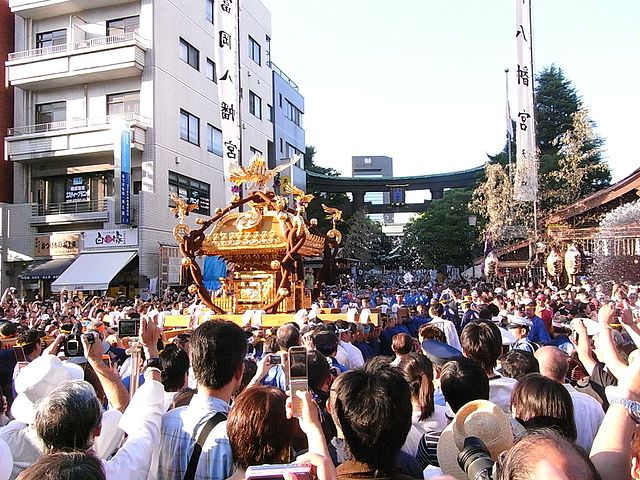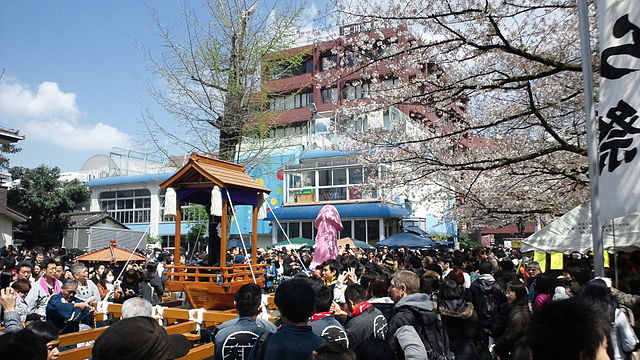
Japanese Festivals: 47 Unique Matsuri From All the Prefectures of Japan
Each of Japan’s 47 prefectures proudly boast their own one-of-a-kind matsuri or japanese festival. Matsuri are a good opportunity to experience the lively local culture and traditional events. For this article, we’ve picked out our favorite Japanese festivals for each of Japan’s 47 prefectures through which you'll be able to see and enjoy another side of Japanese culture!
This post may contain affiliate links. If you buy through them, we may earn a commission at no additional cost to you.
Our Top Tips
JR Pass for Whole Japan
Explore Japan in the most convenient and economical way with a Japan Rail Pass! It is valid for the majority of railways and local buses operated by JR.
*From north to south
1. Sapporo Snow Festival [Hokkaido]
Address: Sapporo, Hokkaido (Google Map)
2. Aomori Nebuta Matsuri [Aomori]

Aomori Nebuta is held from August 2nd to 7th every year in Aomori. Over 20 lantern floats, maximum 5 m tall, parade through the town with chanting and festive music played on Japanese flutes and drums. They are designed after mythological warriots or historical figures. A float is accompanied by 500 to 2000 dancers. This dynamic, lively festival attracts more than 3 million people a year.
HP: www.nebuta.or.jp (Japanese Only)
Address: Aomori, Aomori (Google Map)
3. Morioka Sansa Odori [Iwate]

This festival is held in the evening from August 1st to 4th. Groups consisting of drum, flute, and dancer teams parade through the main street of Morioka. Many dancers also play drums, meaning over 10,000 drums are used during the festival. This is why this festival is called the largest drum parade in Japan. After the lively parade, tourists are welcomed to the folk dance.
HP: www.sansaodori.jp (Japanese Only)
Address: Morioka, Iwate (Google Map)
4. Kanto Matsuri [Akita]
HP: www.kantou.gr.jp/english/index.htm
Address: Akita, Akita (Google Map)
5. Sendai Tanabata Matsuri [Miyagi]
Address: Aoba-ku, Sendai-shi, Miyagi (Google Map)
6. Yamagata Hanagasa [Yamagata]
Address: Yamagata, Yamagata (Google Map)
7. Soma Nomaoi [Fukushima]
This energetic event dating back over a thousand years is held for three days from the last Saturday to Monday in July annually. More than 500 people dressed in traditional armor participate with their horses. Day 1 consists of the ceremonies before the horse events. Day 2 is the highlight of the festival, which has the horse race and the horseback battle. Day 3 is when barehanded volunteers chase a sacred horse in order to capture it. You will feel as if you were back in the Warring States period.
HP: https://fukushima.travel/blogs/fukushimas-soma-nomaoi-festival/122
Address: Minamisoma-shi, Fukushima (Google Map)
8. Ishioka no Omatsuri [Ibaraki]
This festival is called one of the 3 great festivals of the Kanto area. More than 40 mikoshi (portable shrines), floats, and over 30 big horojishi parade in the city. Horojishi is pictured here; the biggest lion head weights 20 kg. On the floats, masked people dance with the festive music. It’s an exciting experience.
HP: https://www.ishioka-kankou.com/page/page000593.html
Address: Sosha-ku, Ishioka-shi, Ibaraki (Google Map)
Our Top Tips
Japan Shinkansen, Narita Express (N'EX) & Express Train Tickets
Plan ahead by booking your shinkansen, airport train, and express train tickets online in English. Have the tickets sent to you by mail or collect them at the station once you're in Japan.
9. Tochigi Aki Matsuri [Tochigi]
This festival is held in the middle of November every two years, and 2016 is the next festive year. The feature of this festival is ten 7m-high floats topped with dolls that are designed after historical or mythical figures. They are accompanied by people dressed in costumes, festive music, and a dance called kagura. Why don’t you take a chance to visit this beautiful town while it's in the middle of festivities?
HP: https://www.visit-tochigi.com/plan-your-trip/things-to-do/1049/
Address: Tochigi-shi, Tochigi (Google Map)
10. Ikaho Matsuri [Gunma]
This festival is held yearly September 18th to 20th in Ikaho Onsen. Mikoshi are carried up 365 steps to the Ikaho Shrine. To see the big mikoshi going up the narrow stairs is a spectacle. However, it is more astonishing to see a taru mikoshi carried up not by hands but on lower backs.
HP: shibu-s.org/index.php?u=161 (Japanese Only)
Address: Ikaho, Shibukawa-shi, Gunma (Google Map)
11. Sawara no Taisai [Chiba]
‘Sawara no Taisai’ is the collective name of festivals held in June and October in Sawara. This is counted as one of 3 great festivals of the Kanto area. The wooden floats are two-storied; festive music performers seated on the lower floor and dolls (4-5m high) are on the upper floor. Some of the dolls are made by locals. 10 floats are used in the summer and 14 in the autumn to parade through the city.
HP: https://www.city.katori.lg.jp/sightseeing/multilingual/en/en-matsuri.html
Address: Sawara, Katori-shi, Chiba (Google Map)
12. Chichibu Yomatsuri [Saitama]
HP: www.chichibu-jinja.or.jp/yomatsuri/ (Japanese Only)
Address: Chichibu-shi, Saitama (Google Map)
13. Fukagawa Hachiman Matsuri [Tokyo]
This annual festival is held around August 15th and is one of the three greatest festivals in Tokyo. Held once every three years (the next one is in 2017), a hon-matsuri featuring the prestigious mikoshi is performed along with about 120 mikoshi, while approximately 50 mikoshi participate in other years. The highlight of the festival is a unique custom to splash water on the mikoshi and its bearers to purify them.
HP: www.tomiokahachimangu.or.jp/htmls/maturih1.html (Japanese Only)
Address: Koto-ku, Tokyo (Google Map)
14. Kanamara Matsuri [Kanagawa]
This fertility festival, held on the first Sunday in April (the next one is April 3rd, 2016), is reportedly one of the most popular festivals among foreigners in Japan. The Kanayama Shrine is dedicated to the deity of mining, metal forging, and sex, so, the sacred object that is enshrined is a steel phallus. You will find lot of items dedicated to it including foods and souvenirs sold by vendors.
HP: http://kawasakidaishi-kanko.com/english/matsuri/kanamara.html
Address: Kawasaki, Kawasaki-ku, Kawasaki-shi, Kanagawa (Google Map)
15. Niigata Matsuri [Niigata]
This biggest summer festival in the region is scheduled to be held from August 5th to 7th in 2016. More than 10,000 people dance to folk music along the main street in Niigata on Day 1. The highlights of day 2 are the 8 mikoshi parading as well as the traditional drum and dance performance by local geisha. The 12,000 fireworks display complete the festival on day 3.
HP: niigata-matsuri.com (Japanese Only)
Address: Niigata, Niigata (Google Map)
16. Takaoka Mikurumayama Matsuri [Toyama]
This festival is held on May 1st. The centerpieces of this festival are 7 gorgeous floats built in the style popular in the 17th century. Beautiful decorations by local artisans adorn them from top to wheel. Takaoka is traditionally known as the center of crafts, including metalwork and lacquerwork. Those floats are lit-up on the evening before the parade so you can see the masterpieces closely.
HP: mikurumayama.jp (Japanese Only)
Address: Takaoka-shi, Toyama (Google Map)
17. Noto Kiriko Matsuri [Ishikawa]
Kiriko festivals are held in more than two hundred areas in the Noto Peninsula from July to October. A number of kirikp, lantern floats indigenous to the region, parade through each town, meaning that seven to eight hundred kiriko in total exist on the island. These majestic festivals are worth visiting if you are in the region.
HP: www.notokiriko.jp (Japanese Only)
18. Mikuni Matsuri [Fukui]
HP: www.mikunimatsuri.com/ (Japanese Only)
Address: Mikunikitahonmachi, Mikuni-cho, Sakai-shi, Fukui (Google Map)
19. Yoshida Himatsuri [Yamanashi]
Sakaori/Wikimedia Comons
This spectacular fire festival is held in annually on August 26th and 27th in Fujiyoshida, at the base of Mt. Fuji. This festival with over 500 years of history is held to keep the volcano from erupting, as well as to celebrate the end of climbing season. More than 70 torches (3m tall and 200kg) are lit in the streets on the 26th.
HP: https://fujiyoshida.net/en/see-and-do/154
Address: Fujiyoshida-shi, Yamanashi (Google Map)
20. Nozawa Onsen Himatsuri [Nagano]
HP: https://nozawa-onsen.com/nozawa-fire-festival/
Address: Nozawa Onsen-mura, Shimotakai-gun, Nagano (Google Map)
Next: No.21-40 Further Festivals in Japan
The information in this article is accurate at the time of publication.





